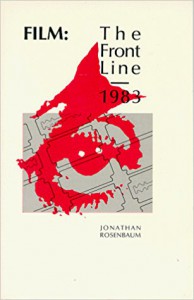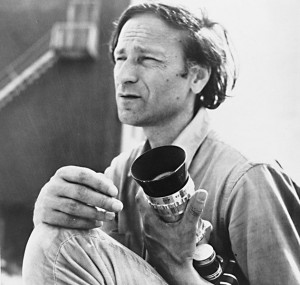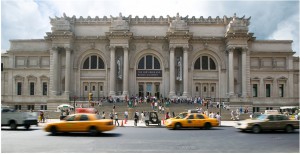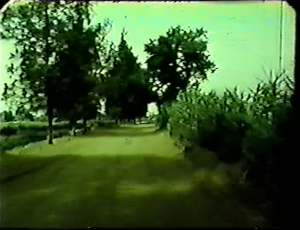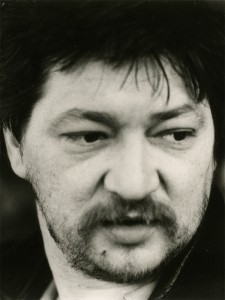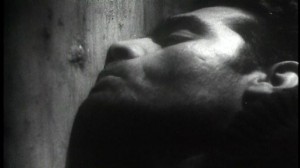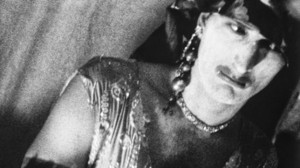From Film: The Front Line 1983 (Denver, CO: Arden Press, 1983). Due to the length of this, I’ll be posting it in four installments. — J.R.
Tenants of the house,
Thoughts of a dry brain in a dry season.
T.S. Eliot, Gerontion
Preface: When I was approached last year about inaugurating a series of volumes surveying recent avant-garde film, I immediately started to wonder about how this could be done. Having lived nearly eight years in Paris and London and about as long in New York, I’ve had several opportunities to note the relative degree of information flow between these and other centers of avant-garde film activity, and the growing isolation of New York from these other centers made my own fixed vantage point less than ideal in some ways. When a colleague told me that Jonas Mekas had recently said that it was no longer possible to know what was happening in experimental film as a whole, a bell of recognition rang in my head, and I knew at once that Mekas was the only available oracle l could turn to. The Lithuanian patron saint of the American avant-garde film, now 60, has been an American filmmaker for at least half of his life, and a chronicler of the avant-garde film in New York — mainly in The Village Voice and (more briefly) Soho News — for at least 15 years. If he no longer knew with confidence where we were, a consideration of the nature of the very problem of our ignorance was clearly in order.
Out of this need and curiosity, the two following conversations took shape, with Mekas’s kind consent, at the temporary headquarters of Anthology Film Archives on Broadway in lower Manhattan, in late July and early November 1982. Robert Haller, executive director of Anthology, was present at both discussions, and some of his remarks are also included.
The second dialogue, longer and somewhat more polemical than the first, occurred during a two-week season at the Public Theater devoted to Jean-Marie Straub and Daniele Huillet and filmmakers they admire (about two dozen films in all) that l was involved in curating at the time, and which became a logical reference point for part of our discussion. The results have been edited by Mekas as well as myself. — J.R.
II.
JM: It has to do with terminology a lot, because terminology can sometimes turn people off from a whole segment of cinema. Like if we say, “These are experimental films” or “These are avant-garde films”. This has never been discussed very much in the open, but maybe it’s time to look into this matter of categories. I tend lately in my own thinking to come to an approach that’s very similar to that of the Metropolitan Museum. That is, I don’t see how we can discuss all the varieties of cinema without setting one group of people against another, unless we take it as a whole. The Metropolitan Museum may not be up to date with the latest trend or vogue in art, but there are rooms for Egyptian art, for Greek art, for Impressionist art. There are different rooms for different styles and periods, and one building houses them all.
So one has to recognize that certain styles and forms are related to a place or time, they may not be repeated later, and you have to take and respect them for what they are. Certain historians gravitate only to one style or school or period. That period could be very brief–10 years or 15. But in cinema we have the situation that either we have writers or historians who are interested only in commercial film — all the Hollywoods of the world — or else just the avant-garde or experimental film, or else some in-between area, like the European independents. Now we have already another group, the American independents, who are neither avant-garde nor Hollywood.
And usually those who write about one group exclude the others. So books and histories keep coming out that present very, very distorted views of film history. With me, this has become a standard practice, as far as the new books on film history go: the first thing I do, I look through the name index. If the names of Kenneth Anger, Stan Brakhage, and Bruce Baillie are missing, I throw the book out as amateurish and not serious.
JR: So what you’re saying, in effect, is that we have no film culture — only film cultures.
JM: There is still this division according to how much it cost to make the film, is it done with amateurs or professionals, is there a union involved, is the government sponsoring it, or a bank, or am i sponsoring it out of my own pocket? That has to go out the window. What has to be stressed are the different varieties of forms, styles, and content areas, such as autobiography, for example. It’s very possible that when we all look back at the history of cinema 20 years from now, we may find that autobiographical film blossomed between 1965 and 1975 or 1980. Then there’s a whole period like direct cinema or cinéma-verité which left its mark and is gone now. The British documentary is another room in itself, just like the social documentaries of a certain period made in this country — or the wartime documentary, which is something else. But when one begins to create one collection of cinema, and that collection is selected by people who are uninterested in so-called “movies” or the avant-garde or the social documentary, of course all other areas will be excluded.
JR: But you’re talking about taxonomy and preservation, which is what a museum does. How does one discover or create the necessity of including a new room? Furthermore, given the existing turf consciousness that seems to rule discourse among many prominent New York film critics — the notion that certain areas and subjects are staked-out property belonging to a few appointed or self-appointed individuals — how can new ideas or approaches manifest themselves? Where can they go? Is there a way of creating or addressing a broad community, or does one have to build another fortress, like Anthology Film Archives, to protect one’s own critical investments?
JM: When we have a film selection committee meeting for Anthology, the films that we review and discuss are those which one of us very passionately stands for and suggests we should see. Therefore, unless there are one or two people who feel very passionately about the film, nothing will work. So that I don’t see “turf” division as you say. Like you just came out recently very passionately for Straub. That is the only way Straub will get roots in this country among the audience and critics — if somebody such as you or Susan Sontag, as she has done, stands very passionately for him. The movement of avant-garde film is where it is today because some of us in the Sixties believed very strongly, and we screened those films and we screened and we screened. And now they are recognized. We managed to put them into the sensibilities and minds and eyes of the people. So if Amy Taubin” doesn’t stand for anybody passionately, nobody is to blame.
Or maybe she does — she stands very passionately for Marjorie Keller’s Misconception. l happened to hate that film with as much passion.
I don’t think one passionate supporter is enough to establish a filmmaker. Maybe there are others. That’s how the turf develops: there must be passionate people defending certain films very passionately. Maybe the problem we have today is that nobody feels very passionately about any film.
JR: I don’t know about that. I’ve been reflecting just recently on Straub and Huillet‚’s last feature, Too Early, Too Late, which I regard as one of the most ethical and beautiful documentaries ever made — although it shares the problem of the Tati film in being truly homeless, rejected or ignored locally by documentary and avant-garde filmmakers alike. On the level of its composition, it’s a film in which the customary relationship for Straub and Huillet between a physical setting and a written text becomes inverted. Here the landscapes are “the body of the text,” while the text becomes the “setting” for those places in France and Egypt–a bit like jazz, where the passing human and animal traffic functions like improvisations on a fixed, given terrain. It’s a film of endless activity supported by a sustained distance, a complete absence of characters, and a continual human presence.
I can understand many of the reasons for Anthology’s selection and fortress strategy — especially now, when we’re entering a time like the early Sixties when people think about living in bomb shelters. But what happens to the avant-garde as a social force, the way it was when you were defending Genet’s Un Chant d’Amour and Smith’s Flaming Creatures? How do the policies of October or Film Culture or Millennium Film Journal encourage young filmmakers or critics to think new thoughts? If October is following the lead of Vincent Canby now in putting Fassbinder at the head of the class, what do we do about people like Straub-Huillet or Wyborny or Ulrike Ottinger? Do we bury them, too, in order to protect our own safety? Finally, if safety and self-preservation become the primary factors in aesthetic decision-making, how does our work differ from that of bankers?
JM: There are many things in your question that I’m not sure are being stated correctly. ”Social force,” for instance: was the avant-garde a social force at any time? And “encourage young filmmakers or critics”: Film Culture was never too encouraging. How do you encourage anybody? I have always argued against film schools and “encouragement”– there is no such thing. From the very beginning, Arlene Croce came on her own to Film Culture; so did Andrew Sarris and Eugene Archer.
JR: Because there was a place they could go to.
JM: They had passion and something to say. It wasn’t because I was encouraging them. How do you encourage a writer?
JR: By allowing people with passions to exist there. By printing them. Where can we go to find that kind of passion today? That’s what I mean by encouragement. It wasn’t simply an old boy network.
JM: | see — a forum to express their ideas. Well, it was much easier at that time, maybe, because there were very few publications. Do we have many today? I don’t know. (Laughs)
JR: (Laughs) I Just named three.
JM: Not that many today. . . .‚”Social force”? Those were different times. The pressures, censorship, was much stronger then; it was imposed on us, and we had to defend ourselves — a clash was inevitable. But today that problem has been removed. It’s more permissive now.
JR: Maybe so. But there’s a way in which institutional acceptance and promotion can take the teeth out of certain kinds of art that have something to do with protest.
JM: What art do you have in mind? The avant-garde of the Forties, Fifties, and Sixties had nothing to do with protest.
JR: You don’t think Flaming Creatures had anything to do with protest?
JM: No, absolutely no. He [Jack Smith] was floating around in that kind of reality. He was obsessed with that reality; he had to do it, and he did it with his friends. It had nothing to do with any politics; it was his world, the life that he lived.
JR: Don’t you think that world and life was formed in relation to something else?
JM: Later, once it was shown, it became political. But the creation of it did not come from any political necessity. On the other hand, if you listen to Jack’s soundtrack in Blonde Cobra, you can see that he himself, as a human being, did not like the type of civilization he saw around him when he walked down the street, obviously. So he created his own world that had nothing to do with what was going on around him in the offices or stores or Park Avenues.
(to be continued)

